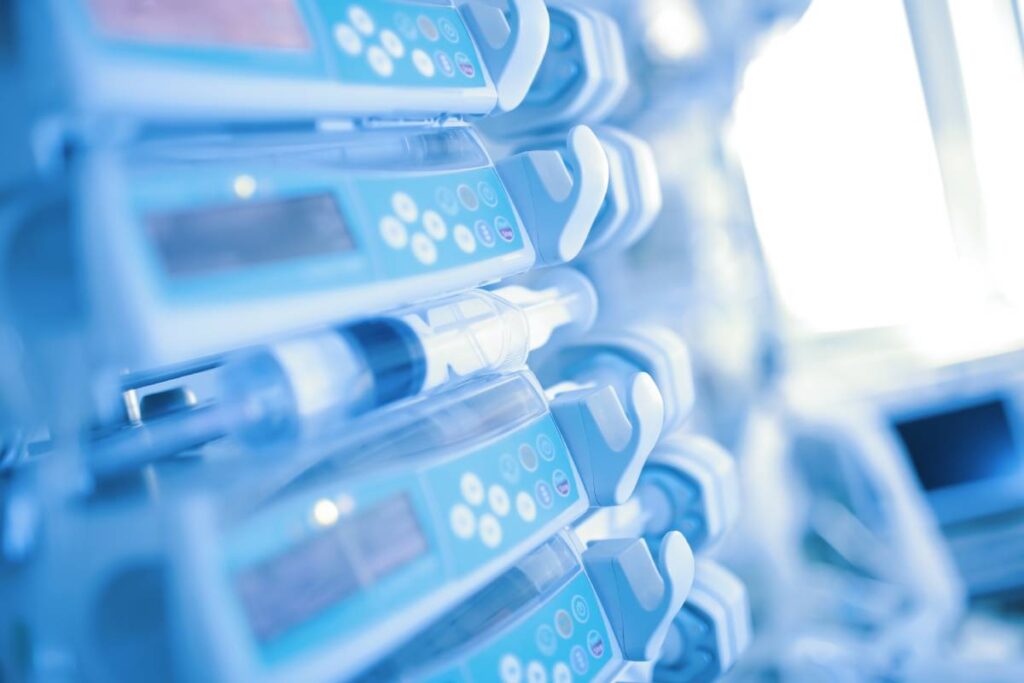An infusion pump is a medical device utilized to deliver controlled amounts of fluids, such as nutrients and medications, into a patient’s body. Infusion pumps play a pivotal role in administering a diverse range of substances, including nutrients, insulin, hormones, antibiotics, chemotherapy drugs, and pain relievers. These pumps find extensive application in various healthcare settings, including hospitals, nursing homes, and home care. Typically operated by trained users, infusion pumps allow for precise programming of fluid delivery rates and durations through an integrated software interface. This advanced technology offers several advantages over manual administration, enabling the delivery of fluids in small volumes and programmed rates or intervals. Syringe pumps are a compact type of infusion pump that are useful for small, precise doses.
Various types of infusion pumps cater to specific needs, such as large volume, patient-controlled analgesia (PCA), elastomeric, syringe, enteral, and insulin pumps. Some pumps are stationary, bedside devices, while others, known as ambulatory infusion pumps, are designed to be portable or wearable. Given their critical role in delivering high-risk medications, infusion pumps incorporate safety features, including alarms, to alert users to potential issues. Modern smart pumps go a step further by warning users about adverse drug interactions or deviations from safety limits in the programmed parameters.
Syringe pumps enable healthcare professionals to administer small amounts of fluid at a precise rate set by the user. The accuracy of these pumps depends on the correct selection of the syringe during programming, with most pumps capable of automatically identifying syringe sizes when the user enters the manufacturer’s name. Syringe pumps are particularly valuable in clinical settings, facilitating the administration of accurate drug or fluid amounts over extended durations. The increasing frequency of syringe pump use in clinical settings underscores their importance, with new models continually introduced to the market.
However, there are several challenges to safe operation of syringe pumps. Delays in initiating an infusion can occur if there is a gap between the syringe driver and the plunger. The significance of this delay may vary; while it may be inconsequential for an adult receiving an antibiotic, it could be critical when initiating an urgently needed fluid infusion in a neonate or a vasoactive drug in a hemodynamically unstable patient. Delays as lengthy as 20 to 75 minutes have been observed in cases where the syringe size is large and the set flow rate is low. Clinicians have employed “workarounds,” such as temporarily doubling the flow rate before connecting the infusion to the patient, but this practice is not recommended due to the potential risk of overdose if the clinician is distracted and fails to reset the pump to the correct rate. Additionally, delays may result from a hysteresis effect (lag time) as the pump’s motor must turn multiple gears during startup.
Parameter entry errors are another potential drawback, as users may manually change the pump settings, leading to mistakes in units of measurement (e.g., changing from mcg/kg per hour to mL/hour). Ambiguities in expected units, such as entering weight in pounds when the infusion pump requires weight in kilograms, can further contribute to entry errors. Alarm malfunction is another significant concern. Infusion pumps may fail to generate an audible alarm for critical problems such as occlusions or the presence of air in the infusion tubing. Conversely, false alarms or delayed warnings about low battery charge may not be displayed in time for a user to prevent pump shut-off during a critical infusion while a patient is in transport. Finally, temporary flow variations may occur due to changes in pump height, resulting in temporary increases or decreases in flow.
Infusion pumps play a vital role in modern healthcare by facilitating precise and controlled delivery of fluids and medications. The evolution of these devices, from manual regulators to advanced smart pumps, reflects a commitment to improving patient safety and treatment accuracy. Despite their significant contributions, challenges such as delays, parameter errors, alarm malfunctions, and unclear warnings underscore the importance of ongoing advancements and careful implementation. As healthcare continues to evolve, addressing these issues will be essential to maximize the effectiveness and reliability of infusion pumps in delivering critical care to patients.
References
1. Examples of reported infusion pump problems. https://www.fda.gov/medical-devices/infusion-pumps/examples-reported-infusion-pump-problems.
2. Kastrup M, Balzer F, Volk T, Spies C. Analysis of event logs from syringe pumps: a retrospective pilot study to assess possible effects of syringe pumps on safety in a university hospital critical care unit in Germany. Drug Saf 2012; 35:563.
3. Neff SB, Neff TA, Gerber S, Weiss MM. Flow rate, syringe size and architecture are critical to start-up performance of syringe pumps. Eur J Anaesthesiol 2007; 24:602.
4. Weiss M, Hug MI, Neff T, Fischer J. Syringe size and flow rate affect drug delivery from syringe pumps. Can J Anaesth 2000; 47:1031.
5. Oh EJ, Hong KY, Lee JH, et al. Simulation Analysis of Flow Rate Variability During Microinfusions: The Effect of Vertical Displacement and Multidrug Infusion in Conventional Infusion Pumps Versus New Cylinder-Type Infusion Pumps. Anesth Analg 2022; 134:59.
6. Schnock KO, Dykes PC, Albert J, et al. The frequency of intravenous medication administration errors related to smart infusion pumps: a multihospital observational study. BMJ Qual Saf 2017; 26:131.

